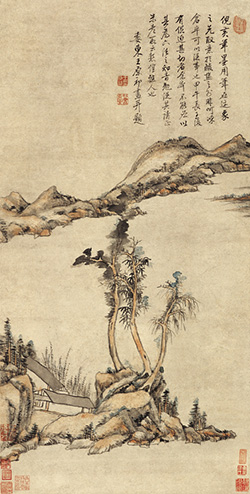| Wang could also create works based on a single formal conceit. In a work of 1714, the crux is a tree, which begins with a typical reference to the great Yuan painter and recluse NI Zan 倪瓚 (1301-1374) . But Wang parts with Ni in the work he makes this tree perform. Ni would have used it to open the space, letting it hold the foreground while a vast depth of thin air and water spread in the midst of the painting, finally being brought to ground with the faint, dry brush reference to a further bank. Wang, however has the tree touch the sliding fragment of landscape above it, linking the back and front of the composition, and so deftly collapsing it. All of the forms now rise up to the surface. Meanwhile the houses at the base of the trees lie jumbled as tokens of a landscape where relative proportions have given way to an entirely artificial confection. This is a painting that dazzles at the surface, both in respect to the surprising, dream-like space that is created and the calligraphic integrity of the strokes that compose it. In respect to colour, it is a work of Wang's own time whereas Ni would have used ink alone. While the black ink recalls Ni and goes grey where the brush dries and drags the surface, the colouring tends to a very un-Ni-like drama, with reds and blues in various tones. | | 
 |